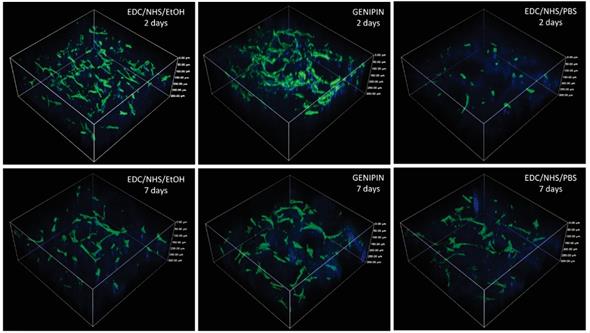- Home
- About the Department
- Staff and contacts
- Study
- Research
- Research Groups
- Laboratory of experimental hematology and stem cells
- Laboratory of Interaction of Cells with Nanomaterials
- Lymphoma Lab
- The Laboratory of Molecular Mechanisms in Blood Diseases
- IronLab - Laboratory of Iron Metabolism
- MicroRNA and transcription factors in regulation of hematopoesis and leukemogenesis
- Laboratory of Proteomics and Extracellular Vesicles
- Publications
- Events
- Research Groups
- Postgraduate study
- Links
Laboratory of Interaction of Cells with Nanomaterials
ABOUT US
The research of the group is mainly focused on interactions between human cells (cell lines and primary cells - osteoblasts, fibroblasts, mesenchymal stem cells, monocytes/macrophages etc.) and surfaces or nanoparticles prepared from different biocompatible materials with controlled properties.
Materials studied by our research group are of different chemistry – carbon (nanocrystalline diamond and graphene), titanium (nanostructured and ultra-fine titanium), biodegradable nanocomposites (based on aliphatic polyester nanofibers with collagen, calcium phosphate nanoparticles and sodium hyaluronan and others), silicon (silicon nanoparticles doped with boron and phosphorus or silicon carbide particles), cerium (cerium oxide nanoparticles) and hyaluronic acid (hydrogels, complexes with surfactants). Used materials are tested as solid surfaces for interaction with adherent cells (implantology, sensing, etc.) and as nanoparticles for sensing, imaging and drug delivery.

The aim of projects concerned on solid
surfaces is to describe the influence of the material properties on the
cell survival, adhesion, growth and differentiation and signaling. Knowledge
gained from our research can be utilized in fabrication of coatings for bone
implants improving the healing process and also, thanks to controllable
electrical conductivity of these materials, in construction of bio-electronic
devices and biosensors.

The aim of projects concerned on nanoparticles is to study the influence of ultra-small nanodiamond nanoparticles, silicon nanoparticles (immunomodulating properties), gold nanoparticles and cerium nanoparticles (anti-oxidative properties) on human cells regarding their utilization as markers for fluorescence microscopy and flow cytometry and as the vehicles for drug or nucleic acid delivery. Thus their biocompatibility, their entry and release from the cell, cellular localization, specific cell targeting and cell response (excretion of molecules and exosomes) are deeply studied

Figure 3: Wide-field fluorescece image os silicon quantum dots in SAOS-2 cell
COLLABORATIONS
National
– Department of Chemical Physics and Optics, Faculty of Mathematics and Physics, Charles University, Prague
- Department of Surface and Plasma Science, Faculty of Mathematics and Physics, Charles University,Prague
- Biomedical Center, Medical Faculty in Pilsen, Charles University, Pilsen
- Department of Genetics and Microbiology, Faculty of Science, Charles University, Prague
- Institute of Dental Medicine, First Faculty of Medicine, Charles University and General University Hospital in Prague
- Institute of Organic Chemistry and Biochemistry of Academy of Sciences of the Czech Republic,Prague
- Department of Composites and Carbon Materials, Institute of Rock Structure and Mechanics, Academy of Sciences of the Czech Republic
- Department of Solid State Engineering, University of Chemistry and Technology, Prague
- PIGMOD Centre, Laboratory of Cell Regeneration and Plasticity, Institute of Animal Physiology and Genetics, Czech Academy of Sciences
- Institute of Physics of the Czech Academy of Sciences, Prague
- Faculty of Electrical Engineering, Czech Technical University, Prague
- Materials Research Centre, Faculty of Chemistry, Brno University of Technology, Brno
International
- Department of Electrical and Electronic Engineering, University of Kobe, Japan
- MTA Wigner Research Centre for Physics, Hungarian Academy of Sciences, Budapest, Hungary
- Institute of Physiological Chemistry, Medical Faculty of Carl Gustav Carus, Dresden University of Technology, Dresden, Germany
Max Bergmann Center of Biomaterials, Dresden University of Technology, Dresden, Germany
- Department of Physical Chemistry and Electrochemistry, Faculty of Chemistry Jagellonian University in Krakow, Poland
- Department of Biology of Animal Environment, Faculty of Animal Science, Warsaw University of Life Sciences, Warsaw, Poland
- Department of Chemical Engineering, Massachusetts Institute of Technology, Cambridge, MA U.S.A
- Department of Materials Science, University of Erlangen- Nurnberg, Germany
- Department of Electrical Engineering and Computer Science, MIT, Cambridge, MA, U.S.A
- Memorial Sloan Kettering Cancer Center, New York, U.S.A
STAFF
Group leader: Prof. RNDr. Marie Hubálek Kalbáčová, PhD.
Pregraduate students: Bc. Victoria Matsakyanová, Pavla Vašinová
Postgraduate students: Mgr. Miriama Sikorová, Mgr. Olga Buchar Klinovská
Postdoc:
Technician: Blanka Bílková
Alumni: Mgr. Antonín Brož, PhD., RNDr. Martina Jannová, PhD., Mgr. Pavla Sauerová, PhD. Mgr. Lucie Vrabcová (Ostrovská), PhD., Mgr. Pavlína Javorová, Mgr. Julie Kadlecová, MUDr. Tereza Vašinová, Mgr. Tereza Bělinová, Ph.D., Mgr. Pavla Tonarová (Sauerová), Ph.D.,
Visiting scientists: Ramon Rioja Gonzalez (Barcelona, Spain), Anna Pawlik (Krakow, Poland), Iwona Lasocka (Warsaw, Poland)